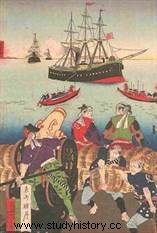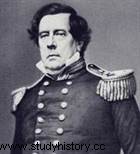 July 8, 1853, an American fleet commanded by Admiral Matthew Perry enters Edo Bay (now Tokyo) and officially requests the opening of Japan to international trade. Japan, an archipelago hitherto isolated from East Asia, is about to experience one of the turning points in its long history. Four American steamers, four "black ships" as the Japanese call them, commanded by Commodore Perry will put an end to more than two centuries of isolation. The Shoguns, who until then had protected the country from foreign interference, will soon only have to give way to a regenerated Empire and an industrial power in the making...
July 8, 1853, an American fleet commanded by Admiral Matthew Perry enters Edo Bay (now Tokyo) and officially requests the opening of Japan to international trade. Japan, an archipelago hitherto isolated from East Asia, is about to experience one of the turning points in its long history. Four American steamers, four "black ships" as the Japanese call them, commanded by Commodore Perry will put an end to more than two centuries of isolation. The Shoguns, who until then had protected the country from foreign interference, will soon only have to give way to a regenerated Empire and an industrial power in the making...
Sakoku:Japanese Isolation
In the middle of the 19th century, Japan was a state whose political structures had hardly changed since the beginning of the 17th century. While there is indeed a monarch, the emperor with divine status, most executive power rests in the hands of the Bakufu (military government) headed by the Shogun.
The Tokugawa Shogunate, which is the result of the process of unification of Japan during the great feudal and clan clashes of the 15th and 16th centuries (Sengoku Jidaï), was maintained in particular through its ability to ensure civil peace within the archipelago. Having domesticated the warrior class (samurai) and the great feudal lords (Daimyos), the Shoguns settled in their capital of Edo (the future Tokyo) would preside over a cultural and commercial development prefiguring a certain modernity. Nevertheless for fear of foreign influences, they also practiced a policy of strict international isolation (Sakoku).
Thus, with the exception of the Dutch trading post at Deshima and occasional relations with China and Korea, Japan lived withdrawn into itself, according to neo-Confucian precepts rather rigid. This was to preserve Japan from foreign merchants, but also from Christian missionaries (Christianity having been banned in 1612), perceived as the vanguard of the armies of Western powers.
Such a conservative policy of isolation could only ultimately lead to a significant technical delay. Thus it is with anguish that Japanese rulers see Westerners imposing their will on the powerful but declining Chinese Qing Empire during the 19th century. Moreover, the Western powers will try several times to push the Japanese to break with their isolation. From threats from American whalers, to Russian advances on Sakhalin and the Kuriles, to British pressure, the Tokugawa Shoguns have reason to worry.
Perry, the Commodore who bent the Shoguns
 They will eventually have to give in to a US Navy officer. Commodore Matthew Perry, pioneer of the steam navy, embarked in 1852 in Norfolk to deliver a message from President Fillmore urging the Japanese authorities to open up to international trade. His steamers (Mississippi, Plymouth, Saratoga, Susquehanna) reached the port of Uraga (near Tokyo) on July 8, 1853. Envoys from the Shogun ordered him to go to Nagasaki, the only Japanese port then open to trade with foreigners.
They will eventually have to give in to a US Navy officer. Commodore Matthew Perry, pioneer of the steam navy, embarked in 1852 in Norfolk to deliver a message from President Fillmore urging the Japanese authorities to open up to international trade. His steamers (Mississippi, Plymouth, Saratoga, Susquehanna) reached the port of Uraga (near Tokyo) on July 8, 1853. Envoys from the Shogun ordered him to go to Nagasaki, the only Japanese port then open to trade with foreigners.
Perry, determined to carry out the mission that the president has entrusted to him, refuses to execute and begins a naval bombardment. The Japanese quickly found that their outdated armament would be powerless against the commodore's "black ships". So they allow him to disembark and present President Fillmore's petitions. When he left a few days later, Perry made it clear to the shogunal authorities that on his next visit serious negotiations would have to begin.
Faced with such a display of power (characteristic of gunboat politics) the Japanese government prefers to be conciliatory. So when Perry returned to Japan, with twice as many ships in March 1854, he was offered the opportunity to negotiate an important commercial convention. This will be the Kanagawa Convention (signed on March 31, 1854). With this treaty, Japan opens new ports (Shimoda and Hakodate) to foreign ships and plans to send an American consul to Japan. Commodore Perry has just started an irremediable process.
A new era for Japan
In barely fifteen years Japan will be forced by several other treaties to open up completely to foreign influences. The resulting economic, social and cultural changes will be at the origin of a political crisis of the first importance. Faced with an active minority convinced of the need to draw inspiration from Westerners (especially on the technical level) in order to preserve the soul of the country, the shogunal authorities preferred to give in to a certain xenophobic backwardness.
Such a short-sighted policy earned them the blow of a civil war, which saw the triumph of reformists rallied under the banner of the Prince Imperial (and future emperor) Mutsuhito. Better known by his posthumous name:Meiji, he was to preside over the dazzling modernization of his country, which at the beginning of the 20th century had become the leading non-Western industrial power.
See our article:The emergence of Japan in Asia.
